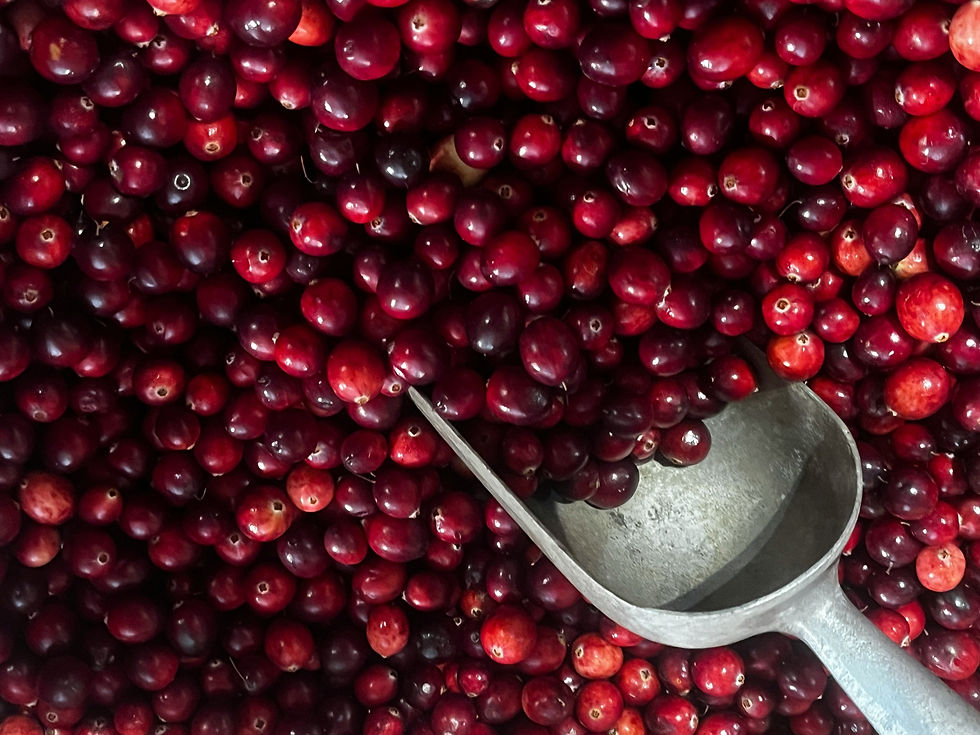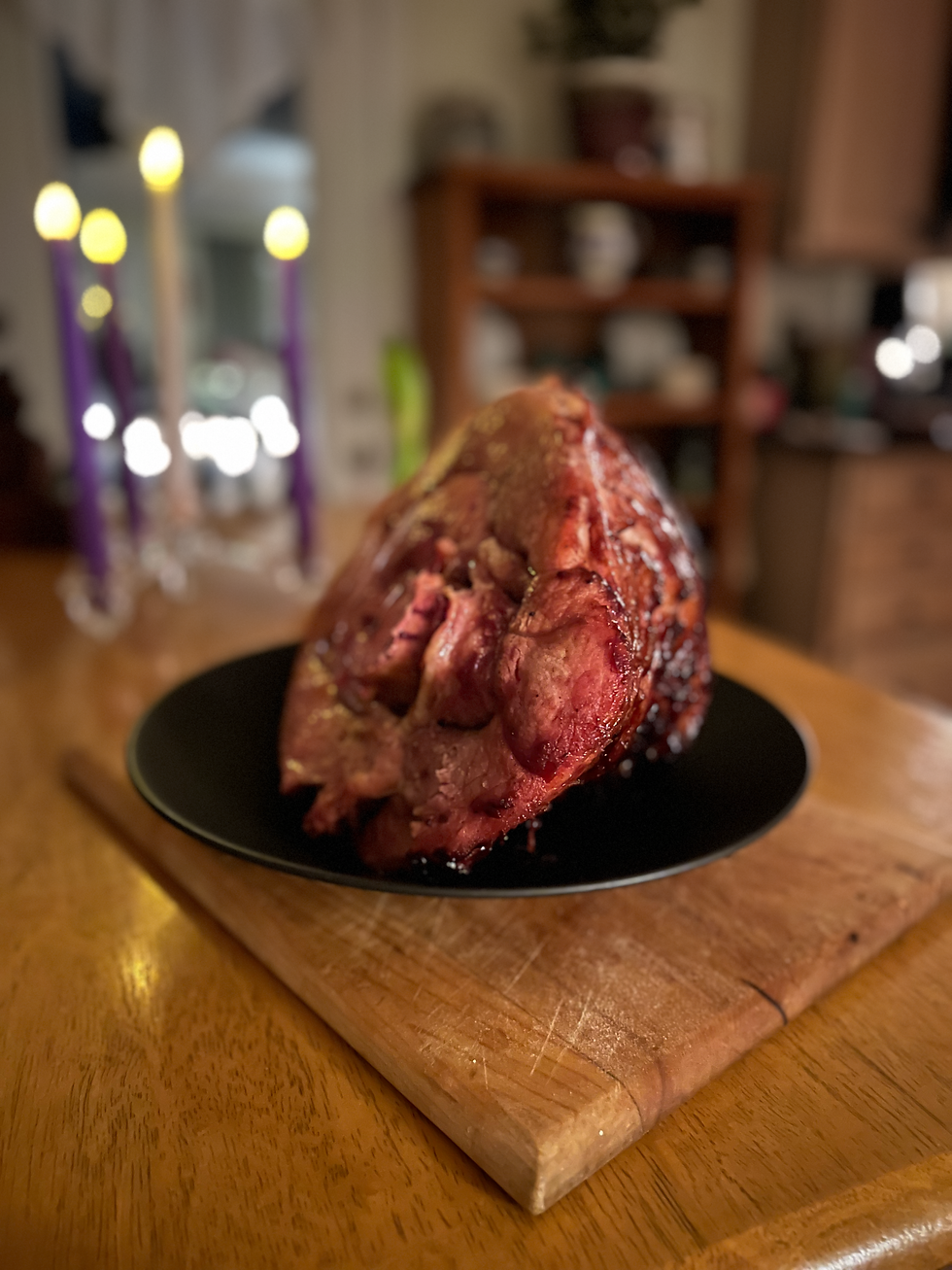Cranberry 101: Your ultimate guide to making the most of seasonal cranberries
- Jen Vondenbrink

- Sep 11, 2025
- 7 min read
Updated: Sep 16, 2025

When the air turns crisp and the leaves begin to blaze with color, another transformation is happening in the bogs of New England. Water floods the fields, creating vast, floating seas of brilliant crimson. This is the sign of the cranberry harvest, a truly unique American tradition that brings us one of autumn's most distinctive flavors, and one I was thrilled to witness every year when I lived on Cape Cod.
Ah, cranberries! Those little ruby-red gems that brighten up our tables during the fall and winter months. Whether you’re whipping up a festive sauce for Thanksgiving or tossing them into a salad for a burst of flavor, cranberries are a versatile ingredient that deserves your attention.
In this guide, we’ll explore everything you need to know about cranberries—from their history and harvesting to how to choose and store them, plus some delicious recipe inspirations to spark your culinary creativity. So grab your apron, and let’s get started!
What is a Cranberry?

Cranberries are small, tangy berries that grow on low-lying evergreen vines in wetlands. They are a superfood and belong to the same family as blueberries and huckleberries, which I didn't realize. These fruits are not just beautiful; they offer impressive flavor and nutrition. Rich in antioxidants, vitamins C and E, and dietary fiber, cranberries provide various health benefits.
The berry itself is small and round with a glossy, deep red skin. What makes it unique is its four tiny, internal air pockets. These pockets are the secret to its iconic harvesting method and give the fresh berry a distinctively firm texture and a surprisingly bouncy quality!
Have you ever bitten into a raw cranberry? If so, you would experience a sharp, astringent tartness that puckers the mouth. It's this very tartness, however, that makes it such a wonderful culinary ingredient, perfectly balancing the sweetness in desserts and cutting through the richness of savory dishes. For instance, think about using them in sauces, jams, and baked goods, but also consider their potential in salads, marinades, and even cocktails!
A Brief History of Cranberries

Long before European settlers arrived, Native American tribes, particularly the Algonquian peoples, cherished the cranberry. They called it sassamanash and used it in a multitude of ways:
Food: They were eaten fresh, dried, and mashed. A staple survival food called "pemmican" was made by mixing dried, crushed cranberries with dried meat and melted fat, crucial for long journeys.
Medicine: Cranberries were used as a poultice to draw out poison from arrow wounds and were believed to have properties that could calm the nerves.
Dye: The vibrant red juice made an excellent natural dye for blankets, rugs, and clothing.
When European settlers arrived in the 1600's, they learned about the berry from the Native Americans. They eventually called it the "crane-berry" because the vine's delicate, pinkish-white flower with its petals swept back resembled the head and bill of a sandhill crane.
The first recorded recipe for cranberry sauce appeared in a cookbook in 1796, and it has evolved into a staple on Thanksgiving tables across the United States. Today, cranberries are celebrated not just for their flavor but also for their health benefits.
The Harvesting Process
While cranberries grow in a few select regions across North America, including Wisconsin (the largest producer), New Jersey, and the Pacific Northwest, they are inextricably linked to the landscape and history of New England.
In Massachusetts, particularly the areas of Cape Cod, Plymouth, and the South Coast, is the historic heartland of cranberry cultivation. The sandy, acidic soil of the region's glacial bogs provides the perfect, unique environment for the cranberry vines to thrive. Driving through this part of the state in the fall, you can see the stunning bogs getting ready for harvest.
The harvest itself is a fascinating process that happens in one of two ways:

Wet Harvesting
This is the iconic image most people imagine: a bog flooded with water and covered in a carpet of floating red berries.
Flooding: The night before the harvest, the bog is flooded with up to 18 inches of water.
Agitating: The next day, farmers use water reels, often called "eggbeaters," to churn the water. This action gently knocks the ripe cranberries off their vines.
Floating: Thanks to their four internal air pockets, the berries float to the surface.
Corralling: The floating berries are then corralled together using large booms and pumped or conveyed off the bog to be cleaned. Berries gathered this way are typically used for juices, sauces, and dried cranberries.
It really is a beautiful process. Driving past the cranberry bogs out of harvest season, you would never know the treasures that the sunken field will produce come September and October.
Dry Harvesting
This less common method is used for the fresh cranberries you buy in bags at the grocery store. Farmers walk behind small, mechanized pickers that look like large lawnmowers. These machines have rotating teeth that comb the berries from the vine, collecting them in a burlap sack. It's a more labor-intensive process, and it doesn't require the field to be close to a water source. It's gentler on the fruit, ensuring it reaches you in perfect condition.
Choosing Fresh Cranberries
Selecting fresh cranberries is essential for the best taste. Look for berries that are firm, plump, and bright red. Avoid any that are soft, shriveled, or have blemishes. Fresh cranberries should be shiny and vibrant, signaling their freshness.
You can typically find fresh cranberries in grocery stores from late September through December. If you have access to a local farmer’s market, take advantage of that for the freshest options!
Don't forget to check out dried cranberries out of season or even in season to add another cranberry dimension to your dishes. They are perfect to have around to add to sauces, soda bread, or scones, and oatmeal cookies.
How to Store Cranberries
You can store fresh cranberries in your refrigerator for up to two weeks. Keep them in their original packaging or transfer them to a breathable container to maintain their freshness.
If you want to store them longer, consider freezing them. If you buy fresh loose cranberries, rinse them, then spread them out on a baking sheet to freeze individually. Once frozen, transfer them to a freezer-safe bag.
Even easier, and this is what I do, when I buy them at the grocery store, I freeze them right in their own bag. Simple! Frozen cranberries can last for up to a year so you can have the wonderful taste of cranberries long after the harvest. I love cooking with cranberries in the spring before the seasonal soft berries are ready. It is the perfect bridge between winter, spring, and ultimately summer.
Creative Ways to Use Cranberries
Now that you know about cranberries, let’s explore some delicious ways to incorporate them into your cooking:
Sweet Treats
Cranberry Sauce: A classic dish that must be on your holiday table. Combine fresh cranberries with 1 cup of sugar, 1 cup of orange juice, and a pinch of cinnamon for a simple yet flavorful sauce.
Cranberry Muffins: Start your day with cranberry muffins! Mix one cup of fresh cranberries into your favorite muffin batter for an uplifting breakfast treat.
Classic Cranberry Orange Scones: The tartness of the cranberry is a perfect match for the sweet citrus notes of orange. Add a simple orange glaze for a perfect breakfast treat.
Cranberry Orange Soda Bread: If you aren't a fan of scones because they are too sweet for you (or at least some American scones can be), then consider making this cranberry orange soda bread using dried cranberries. It is craveable!
Cranberry Bars: These are delicious and you may even feel healthy eating them because they are filled with oats and cinnamon (but yes there is butter in them as well)
White Chocolate and Cranberry Cookies: A modern classic for a reason! The sweet, creamy white chocolate perfectly balances the chewy, tart dried cranberries.
Cranberry Apple Crisp: Combine fresh cranberries with sweet apples for a pie filling. Top with a buttery oat crumble for a warm, comforting dessert.
Sparkling Sugared Cranberries: A beautiful and simple garnish. Roll fresh cranberries in egg white, then in sugar, and let them dry. They look like frosted jewels and add a sweet-tart pop to cakes, cocktails, and cheese boards.
Cran-Raspberry Frangipane Tart: If you are a fan of the Great British Baking Show, then you've heard the term Frangipane Tart. If you aren't sure what that is, it is a tart filled with an almond paste that you bake. In this case, I've made a jam with cranberries and raspberries for the perfect complement.
Savory Dishes
Cranberry Glazed Chicken: Make a sweet and tangy glaze for chicken by simmering fresh cranberries with ¼ cup of honey, ¼ cup of soy sauce, and a minced garlic clove. This dish is sure to impress!
Spicy Cranberry Chutney: Simmer fresh cranberries with onions, apples, vinegar, sugar, and spices like ginger, cinnamon, and a pinch of cayenne. It’s a fantastic condiment for roasted pork, chicken, or a sharp cheddar cheese.
Cranberry-Glazed Turkey Meatballs: Simmer your favorite turkey meatballs in a simple sauce made from whole berry cranberry sauce, chili sauce, and a little soy sauce for a crowd-pleasing appetizer.
Harvest Salad with Cranberry Vinaigrette: Add a handful of dried cranberries, toasted pecans, and goat cheese to a bed of mixed greens. Top it with a vinaigrette made by blending whole cranberry sauce, olive oil, balsamic vinegar, and a touch of Dijon mustard.
Ina Garten's Butternut Squash Salad: This is a perfect holiday salad filled with sweet roasted butternut squash, pecans, and dried cranberries.
Cranberry Salsa: A festive and surprising appetizer. Finely chop fresh cranberries and combine with jalapeño, cilantro, red onion, lime juice, and a little sugar. Serve over a block of cream cheese with crackers.
For more inspiration, check out delightful recipes featuring cranberries. You’ll discover everything from savory delights to sweet treats that will excite your taste buds!
Embracing the Flavor of Cranberries
Cranberries are more than just a seasonal fruit; they’re a versatile ingredient that can elevate your cooking throughout the year. With their rich history, vibrant flavor, and numerous health benefits, it’s clear why they are beloved in kitchens everywhere.
So the next time you spot fresh cranberries at the store, don’t hesitate to grab a bag (or two!). Experiment with various recipes, and let your creativity shine. Whether you’re whipping up classic cranberry sauce or trying something novel, these little berries are sure to bring a burst of flavor to your dishes.
Happy cooking!







Comments